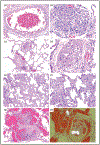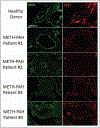Methamphetamine and the risk of pulmonary arterial hypertension
- PMID: 30036313
- PMCID: PMC6880795
- DOI: 10.1097/MCP.0000000000000513
Methamphetamine and the risk of pulmonary arterial hypertension
Abstract
Purpose of review: Methamphetamine is a highly addictive drug originally developed for the treatment of neuropsychiatric disorders. At present, the epidemic rise of illicit methamphetamine use has increased the number of patients living with medical complications. Our group has recently identified a definite association between methamphetamine use and pulmonary arterial hypertension (PAH), a life-threatening disease characterized by occlusive vasculopathy and progressive right heart failure. This review will discuss the evidence that links methamphetamine with PAH and how to approach the diagnosis and management of methamphetamine-associated pulmonary arterial hypertension (Meth-APAH) patients in clinic.
Recent findings: Compared with idiopathic (I) PAH, Meth-APAH patients present with worse functional status, right ventricular dysfunction, and exercise tolerance. Despite therapy, the 5-year survival of Meth-APAH patients is significantly lower compared with IPAH. Genetic studies suggest that loss of function variants in genes involved in drug detoxification can increase susceptibility for methamphetamine-related vascular injury and trigger occlusive vasculopathy.
Summary: PAH patients undergoing diagnostic evaluation should be screened for a history of current or past methamphetamine use. Pharmacovigilance should be implemented to monitor patients being treated with methamphetamine for neuropsychiatric disorders (e.g., attention-deficit hyperactivity disorder). More studies will be needed to identify which susceptibility factors increase risk of PAH in methamphetamine users.
Conflict of interest statement
Conflicts of interest
There are no conflicts of interest.
Figures




References
-
- Romberg E Ueber Sklerose der Lungen arterie. Dtsch Archiv Klin Med 1891; 48:197–206.
-
- Hatano S, Strasser T, World Health Organization. Primary pulmonary hypertension: report on a WHO meeting, Geneva, 15–17 October 1973. Edited by Hatano S and Strasser T. Geneva: World Health Organization; 1975.
-
- Galiè N, Humbert M, Vachiery JL, et al. 2015 ESC/ERS Guidelines for the diagnosis and treatment of pulmonary hypertension: The Joint Task Force for the Diagnosis and Treatment of Pulmonary Hypertension of the European Society of Cardiology (ESC) and the European Respiratory Society (ERS): Endorsed by: Association for European Paediatric and Congenital Cardiology (AEPC), International Society for Heart and Lung Transplantation (ISHLT). Eur Heart J 2016; 37:67–119. - PubMed
-
- Montani D, Bergot E, Günther S, et al. Pulmonary arterial hypertension in patients treated by Dasatinib. Circulation 2012; 125:2128–2137. - PubMed
Publication types
MeSH terms
Substances
Grants and funding
LinkOut - more resources
Full Text Sources
Other Literature Sources
Medical
Research Materials
Miscellaneous

